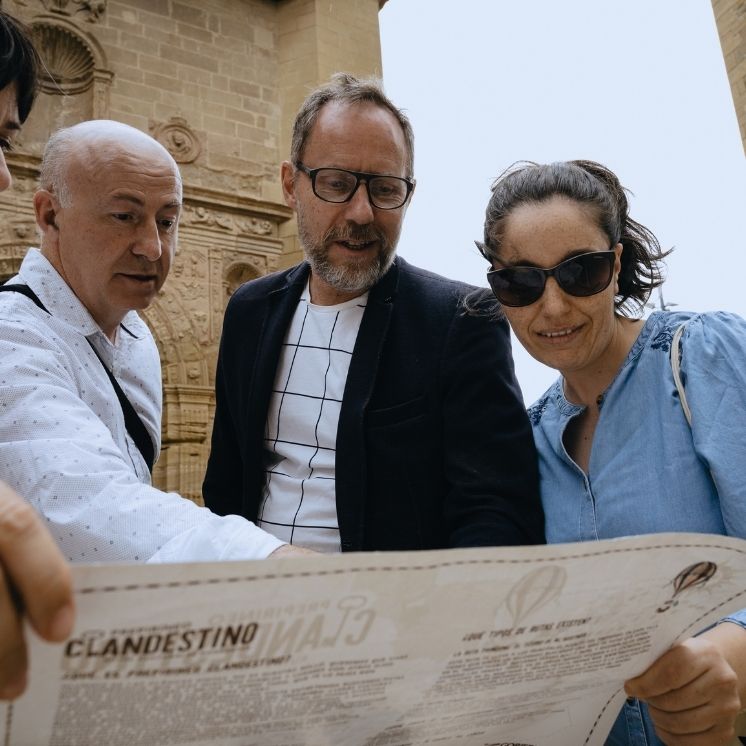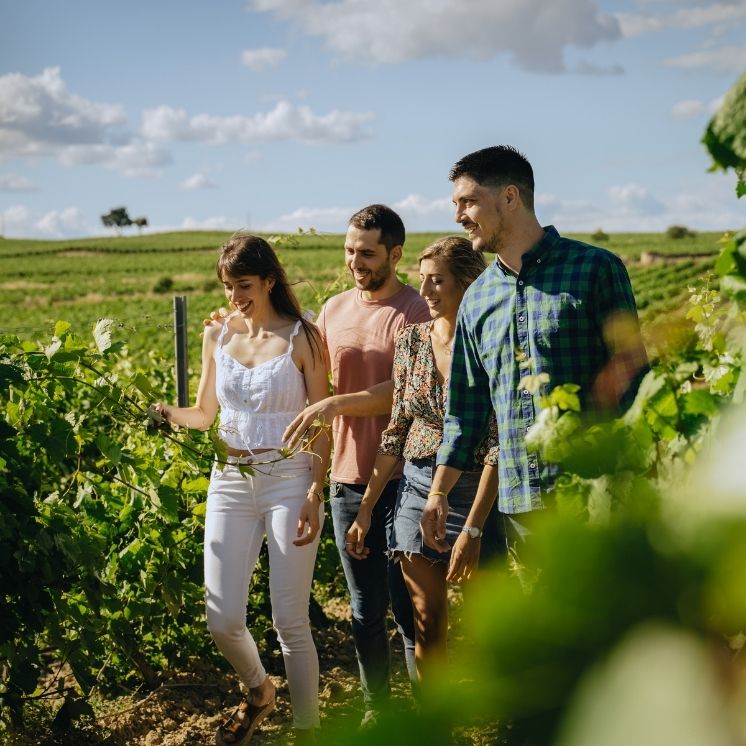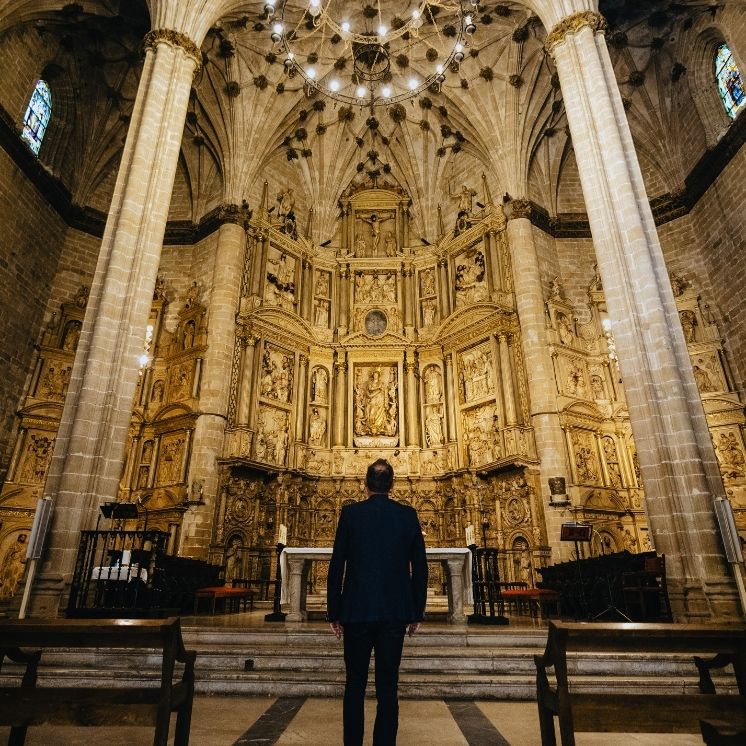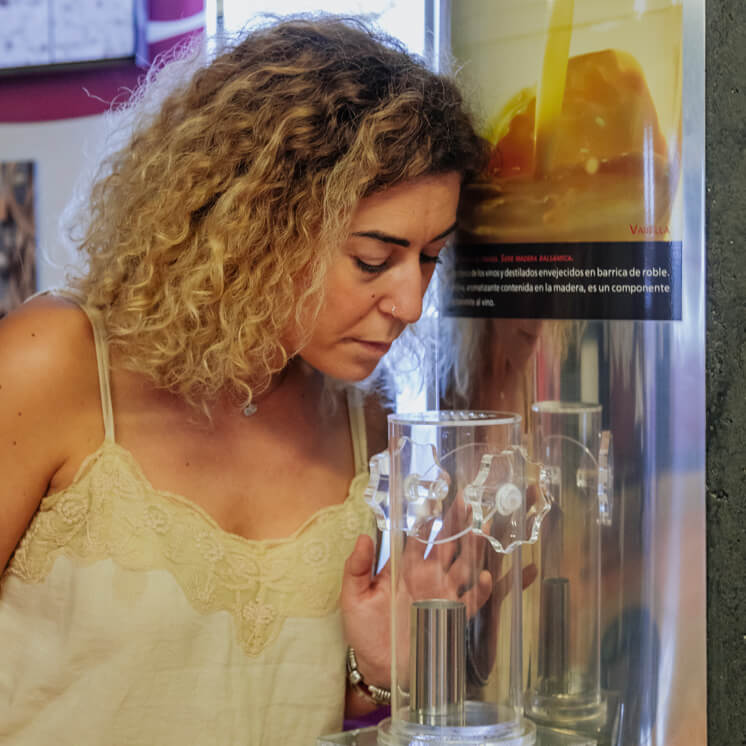Barbastro
Our story begins In Barbastro. The capital of Muslim Barbitania and of the Christian Somontano. A place rich in heritage, culture, and cuisine that invites you to explore and enjoy the slow life.
We’re going to give you some clues so that you can find the treasure. They are spread throughout the city, and you need to get them in the correct order. Remember to bring paper and pen. When you have them all, you will have the key to unlock the location. At the bottom of the page, you have access to the treasure. You have to enter the clue numbers in the correct order: the first number of the first clue, the second number of the second clue, and so on.
PETRONILA’S SEARCH FOR THE TREASURE
Petronila liked silence. Which is why was she alone all her life. She did not remember her parents. They left when she was still very young. She was not even two years old when they decided on her destiny and left her. She was the first Queen of Aragon. A position that many would have liked. Queen without a kingdom, married at two years old, and alone. But feeling sorry for her would not please her. She descended from a great king: Sancho Ramírez, The Fighter. He had to overcome compassion and fight for his future.
She was told about Al-Muqtadir’s treasure by her aunt Sancha de Castilla, who was obsessed with it and with raising funds for her return to Europe. Petronila’s objective was more banal: survival. While it is true that she was the real queen of Aragon, it was also true that she seldom made a decision about anything. She remembered other queens who had ended up in small convents, with nothing. Petronila did not want to end up like that, she wanted comfort in her retirement, and for that she needed money.
When she started her search, she thought that perhaps it had never left Barbastro. She had been a part of this city, almost since her birth, so spent her time looking for it here.
Of the Barbastro in which they had betrothed her to the count of Barcelona, there is not much left. The clues that she had to follow have become blurred, but we have new clues that will guide you to the exact place where Petronila may have found the treasure. But who knows? It might still be there.DOWNLOADABLE MAP AND ROUTES
CLUE NO.1 CATHEDRAL OF BARBASTRO
It could be called the Cathedral of flowers. More than 400 gilded wooden roses bloom in the vaults of the cathedral. It looks like a celestial garden. There, high up, more than 15 meters above us, different flowers together with their arabesques, their shields, and their apparent fragility hang from the ribs of the Gothic ceiling.
And below, the artist’s statement runs through the temple – half graffiti, half declaration of love: “So beautiful. You are my friend, and in you, there are no defects. Oh Lord, your house is built on solid rock …”: Year 1531.
The cathedral of Barbastro was built to help the city recover its status as Episcopal See. They made great efforts to build on the remains of the old church, which in turn rested on a mosque, a magnificent building with more surprises inside than outside. The best artisans were called to build it – among them the sculptor Damián Forment, who together with his assistants, made the main altar in alabaster.
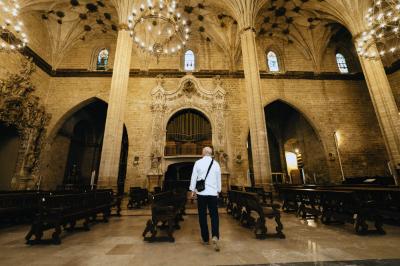
Hint: A SELFIE OF THE XVI CENTURY
HOURS
LOCATION
Hint: A SELFIE OF THE XVI CENTURY
In the sixteenth century, they also made selfies. Of course not as quickly as now. Search the high altar for the selfie that the sculptors made of Master Formet and his wife.
Count the number of angels around them. It will be your first clue to unlocking the treasure.
HOURS
GUIDED VISIT SCHEDULES
Tuesday to Saturday
Mornings: 10:00 – 10:30 – 11:00 – 12:30 – 13:00 – 13:30
Afternoons: 16:30 – 17:00 – 17:30 – 18:00 – 18:30 – 19:00
Sundays : 10:00 – 10:30 – 11:00
ENTRANCE IS BY THE DOOR OF THE PALACE (Opposite the Museum)
PRICES: 2€ Cathedral; Joint Entry Cathedral and Museum 4,50€
LOCATION
CLUE NO.2 DIOCESAN MUSEUM
The Diocesan Museum is like a treasure chest. It has treasures inside, and its exterior seems impregnable. Only the gallery of upper arches reduces the solemnity of the Renaissance building that was once the Episcopal Palace. Its massive door invites us to discover the wonders it keeps inside.
Inside you can take a walk through time; through different historical periods from the High Middle Ages to the modern era. Your gaze will be reflected in the magnificent collection of religious art pieces from the Diocese of Barbastro-Monzón; with artistic styles ranging from Romanesque to Gothic, Mudejar, Renaissance, and Baroque.
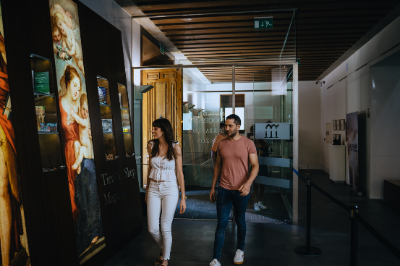
Hint: FANTASTIC ANIMALS
HOURS
LOCATION
Hint: FANTASTIC ANIMALS
Count the number of fantastic animals you find in the Museum. Manticores, dragons, and defeated demons expressively representing evil. Don’t forget to look at the ceiling. They can be anywhere.
HOURS
Tuesday to Saturday
Morning: from 10:00 to 13:00
Afternoon:
(From October 1 to May 31): 16:00 to 19:00
(From June 1 to September 30): 17:00 to 20:00
Guided visits: With prior reservation (minimum 24 hours) and according to availability.
SUNDAYS AND HOLIDAYS: Morning: from 11:00. to 14:00
MONDAY (including holidays): Closed.
Open mornings only: December 24 and 31
CLOSED:
Mondays (including holidays)
January 1 and 6
Good Friday
May 1,
September 4 and 8,
December 8 and 25
To arrange the visit at other times, you can make contact by phone 974 315 581 or Email: info@museodiocesano.es
LOCATION
CLUE NO.3 MARKET SQUARE
Barbastro is a commercial city. In the High Middle Ages, the markets were held in the Plaza de la Candelera. But in the fifteenth century, the square became too small, and the local market was moved to the current market square, where it still takes place on Saturdays.
The Somontano pantry is very large, with wonderful quality products: Wine, oil, pink tomatoes, sweets, are products that are available daily in Barbastro. Not for nothing was Somontano designated Territorio de Interés Gastronómico de Aragón in 2018.
Do not go home without treating yourself to its delights!
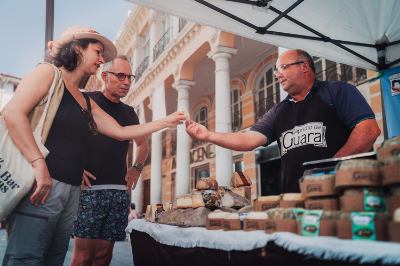
Hint: MARKET WITH COLLONADE
HOURS
LOCATION
Hint: MARKET WITH COLLONADE
There are no remains of the original 15th-century market except for some of the typical arched porticoes which have been maintained. Count how many columns there are in the square. Add up the number until there is only one digit left.
HOURS
Tourist Office of Barbastro
Plaza Guisar, 1-3
22300 Barbastro (Huesca)
974308350
ofiturismo@barbastro.org
Tuesday to Saturday from 09:30 to 14:00 and from 16:00 to 19:00
LOCATION
CLUE NO.4 MAIN STREET
The main street of Barbastro is rarely known by that name. It is generally called the Street of the Argensolas. Why? Because in this street is the house where the Argensola brothers, poets and historians of Barbastro, were born. It is one of the best examples of an ancestral Manor house of the Aragonese Renaissance.
In the corner of the Market Square, you can also see the birthplace of the Founder of Opus Dei, José María Escrivá, who was also from here. Today his house has been converted into a Cultural Centre.
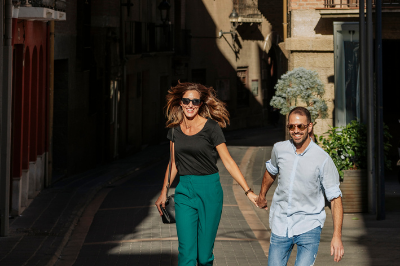
Hint: PILGRIMAGE TO SANTIAGO HOURS LOCATION
HOURS
LOCATION
Hint: PILGRIMAGE TO SANTIAGO HOURS LOCATION
In the main street, many noble families had their homes. For example the Facetos, of Sin in the Gistau Valley. At number 6 you can see their noble shield. How many shells appear?
HOURS
Tourist Office of Barbastro
Plaza Guisar, 1-3
22300 Barbastro (Huesca)
974308350
ofiturismo@barbastro.org
Tuesday to Saturday from 09:30 to 14:00 and from 16:00 to 19:00
LOCATION
CLUE NO.5 COSO
El Coso is the heart of Barbastro. The ideal place to drink some wine, snack, dine or have lunch and watch the city life pass by from its sidewalk tables.
From 1930, when vermouth and banderilla became fashionable drinks in Barbastro, to the present day, the food and drink business in Barbastro always offers something new. Do not be confused by their style – although they seem new, some of the gastro bars have been open for almost 100 years.
El Coso is the ideal place to relax and enjoy the wines and rich gastronomy of Somontano.
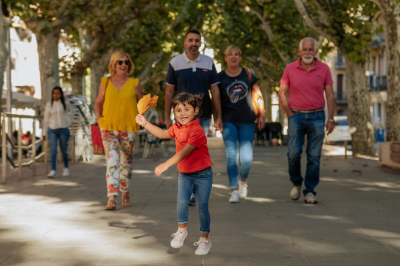
Hint: TREES WHY DO I LOVE YOU
HOURS
LOCATION
Hint: TREES WHY DO I LOVE YOU
El Coso was built in 1848 over the town’s main drainage culvert, converting a fetid ravine into the most bourgeois street of Barbastro. Trees were planted in it: Try to identify them. Add the letters of their name until you have only one digit left.
HOURS
Tourist Office of Barbastro
Plaza Guisar, 1-3
22300 Barbastro (Huesca)
974308350
ofiturismo@barbastro.org
Tuesday to Saturday from 09:30 to 14:00 and from 16:00 to 19:00
LOCATION
CLUE NO.6 COMPLEX OF SAN JULIÁN
complex currently hosts the “Wine Space”. Here you can find one of the most famous specialities of the area: the wine of the Somontano Denomination of Origin.
Talking about Barbastro and not talking about wine is inconceivable. Almost 100 companies are dedicated to winemaking here. If you want to understand it better, we recommend you follow “The Wine Route” or if you prefer to mix your wine with music, the “Somontano Wine Festival”
And finally, end your visit to this complex with the Barbastro bullring that has a museum.
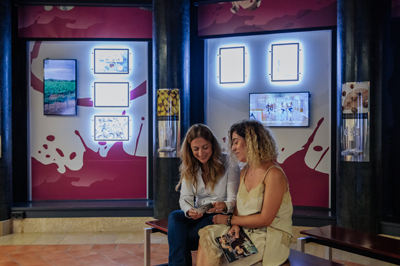
Hint: DISCOVER THE SOMONTANO
HOURS
LOCATION
Hint: DISCOVER THE SOMONTANO
The “Denominación de Origen” Somontano uses a great variety of grapes to make its wines. If you paid attention in the Wine Space, it will be clear. How many varieties make up this denomination? Add the numbers until you have a single digit.
HOURS
Tourist Office of Barbastro
Plaza Guisar, 1-3
22300 Barbastro (Huesca)
974308350
ofiturismo@barbastro.org
Tuesday to Saturday from 09:30 to 14:00 and from 16:00 to 19:00
LOCATION
CLUE NO.7 COMPLEX OF SAN FRANCISCO
Why do its irregular shapes and colours attract us so much? The houses of different heights and colours around the Vero are hypnotic. Separately they say nothing; they are just ordinary houses. Together they create a perfect balance of colours and shapes.
From there we can see the complex of San Francisco,,, its church, the ornamental fountains that supplied water to Barbastro less than a century ago, and a huge olive oil press. It was moved from its original location, Puy de Cinca, to here and shows us how the oil was extracted.
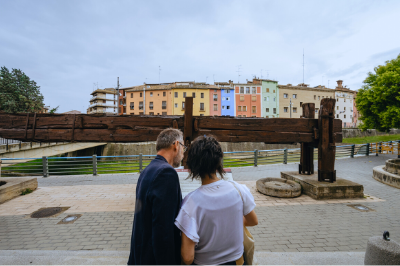
Hint: OIL AND WATER DON’T MIX
HOURS
LOCATION
Hint: OIL AND WATER DON’T MIX
How many parts of water are mixed with one part of oil to make the famous Castile Soap with which Petronila and also some very famous knights from Flanders would wash? Take only the second digit of the ratio.
HOURS
Tourist Office of Barbastro
Plaza Guisar, 1-3
22300 Barbastro (Huesca)
974308350
ofiturismo@barbastro.org
Tuesday to Saturday from 09:30 to 14:00 and from 16:00 to 19:00
LOCATION
DO YOU HAVE ALL THE CLUES?
UNLOCK THE TREASURE
Remember that you must put all the numbers you have obtained in the clues in the correct order, according to the Web page.




